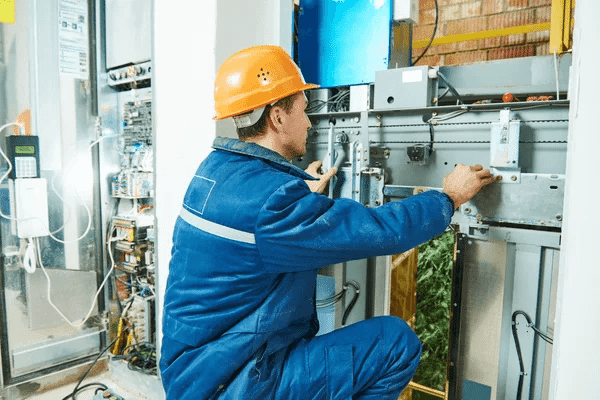What Type of Passenger Lift Do You Have – Hydraulic, Traction, or Gearless?
Hydraulic, traction, and gearless lifts are all common types of passenger lifts. They each have their own advantages and disadvantages, which we’ll cover below.
Hydraulic lifts are the most common type of passenger lift. They’re also the most expensive option because they require hydraulic fluid to run correctly. Hydraulic lifts can be used in various environments—from offices to buildings with high ceilings—and can accommodate heavier individuals than other lifts.
Traction lifts are the least expensive option for companies purchasing a new passenger lift. They’re made up of an elevator car that moves along rails in a shaft (or “tread”), powered by an electric motor at both ends. The motor works like a pulley system: as the car moves down the shaft, one end pulls while the other pushes back against gravity, so there is no friction between it and its supports (typically metal cables). This means traction lifts are typically only used for short distances within buildings or campuses where space is limited—but they’re still capable of carrying up to 500 pounds per person!
Gearless lifts are another popular choice for elevators, and they’re often used in more significant buildings that require greater capacity. They’re similar to traction lifts in that they also use cables to move people up and down between floors—but instead of relying on a motorized pulley system, they use gears to drive the car up and down.
Gears are essentially a set of interlocking teeth that allow the car to move up and down at a certain speed. The gears can be manually operated by an operator or controlled by computer software, differentiating gearless elevators from traction lifts.

What is The Capacity of Your Passenger Lift – How Many People Can It Hold At Once?
Step 1: Check the maximum weight capacity of your passenger lift. The weight capacity is typically indicated on a small sticker attached to the base of the passenger lift or sometimes in the owner’s manual.
Step 2: Find out how many people can ride at once. This number is usually based on standard weight measurements (for instance, a person who weighs 200 pounds will count as 2 people). If you don’t have access to this information, you can use an online calculator such as.
Step 3: Check with your local building codes office to see if there are any restrictions regarding the number of people allowed in a single-person elevator car at one time. Some states specify that no more than 3 people can ride in an elevator car at one time, while others require that no more than 5 people can ride in an elevator at one time.
If none of these factors limit the number of passengers who can ride in your elevator car at once, then you’re good to go! You’ve discovered how many people can fit inside your passenger lift without exceeding its maximum capacity limits or violating local building code requirements! So, how many people can fit into an elevator car? The answer depends on the size of your passenger lift and your state. Some states have specific rules regarding the maximum number of people allowed in a single-person elevator car at one time. In contrast, others leave it up to local building code regulations.
Knowing how many people can fit inside your lift car is essential if you’re planning to install a new passenger elevator. The limit is determined by the size of your elevator cabin and state regulations. In most cases, you’ll need a “certificate of occupancy” before you start construction on any building project.

What is The Size of Your Passenger Lift – What are The Dimensions (Height, Width, Depth)?
We are a professional elevator parts supplier. We sell all kinds of elevator parts and provide excellent customer service to our customers. In this article, we will tell you the size of your passenger lift – what are the dimensions (height, width, depth)?
First, look at the dimensions of your passenger lift: height, width, and depth. Then measure them with a ruler or measuring tape to ensure accurate results. The height and width are usually measured in millimeters, while the depth is measured in centimeters or inches.
Second, now that you have those measurements, you need to find out how many meters/feet each dimension is to calculate your total area in square meters/feet. For example, if your height is 3 meters, then 1 meter equals 100 centimeters; 3×100=300c㎡ means 300c㎡ makes one square meter (㎡). So after multiplying 3 by 100, we get 300㎡, meaning that our total area is 300 ㎡ (ft²). Similarly, if our width was 7 meters, 1 meter equals 1 meter; 7×1=7 ㎡ means seven ㎡ in one square meter. So after multiplying 7 by 1, we get 7㎡ which means that our total area is 7㎡ (ft²).
Third, now that you have those numbers, you can calculate the total area of your house in square meters/feet by adding up all the dimensions. Let’s say your house measures 3 meters wide by 7 meters long and 2 meters high.
You would then add up all those numbers to get: 372=12㎡ Now that you know the total area in square meters/feet, you can convert it into acres.

Is Your Passenger Lift In Need of Any Repairs or Maintenance Currently?
If your passenger lift is in need of any maintenance or repairs, we have everything you need. We have the parts you need for your lift to function properly and safely.
The following are some of the steps you can take to ensure that your lift is functioning optimally:
1. Check your elevator’s brakes and make sure they are working correctly. If they aren’t, they may need to be repaired or replaced.
2. Check the cables on your elevator to make sure that they aren’t loose or damaged in any way. If so, they will also need to be repaired or replaced.
3. Inspect the safety door on your elevator to make sure it is closed tightly and securely locked into place at all times when in use by passengers riding inside this compartmentalized section.
How Much Are You Willing to Spend On New Passenger Lift Parts?
When you need to replace a part of your passenger lift, you must know how much you can afford to spend. If you don’t, you could spend more money than is necessary or buy a part that isn’t compatible with your lift.
The first step in determining the cost of new passenger lift parts is to estimate how much it will cost to install them. When choosing a lift installer, consider their reputation and experience in installing lifts like yours. This may be a good choice if they have worked on similar lifts and have good reviews from previous customers. However, if they have limited experience with installs similar to yours—or no experience with them—this may not be the best choice for your situation.
Next, determine what type of equipment you need to purchase. For example, suppose you have a broken motor and want to replace it but don’t know where or how to buy one. In that case, this might be worth researching before committing any money to anything else that might not work, like replacement parts for other mechanical parts such as wheels, drive motors, etc. This is especially true for older models where parts are no longer available from the manufacturer. In addition, you may want to consider the repair costs of parts that are still available and their availability; if they are only available through a specific company or individual, it may be more challenging to find someone willing to work on your machine.
Finally, you may want to consider the availability of replacement parts for your specific model. This is especially true if you have an older machine where parts are no longer available from the manufacturer. In addition, you may want to consider the repair costs of these parts and their availability, if they are only available through a specific company or individual, this may make it more difficult for someone to work on your machine. If you have any questions or want to get started on your own lift, email us at info@dazenelevator.com, and we will reply within 24 hours.

